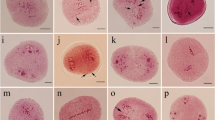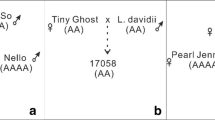Abstract
A triploid was obtained from loquat (Eriobotrya japonica cv. ‘Ninghaibai’) (2n = 2x = 34) × bronze loquat (Eriobotrya deflexa, 2n = 2x = 34). The leaves of the triploid had no petioles, similar to the female parent, and its stipules were obvious and dark green, similar to those of the male parent. There were signals of male parent DNA on ten chromosomes of the triploid according to genomic in situ hybridization (GISH) when DNA of bronze loquat was used as probe; the diploid hybrid also had ten chromosomes with signals of male parent DNA. All five selected simple sequence repeats (SSR) primers amplified specific loci of both parents. In particular, primer CH04c06 amplified both specific loci of the female parent but only amplified one specific locus of the male parent. The results of GISH and SSR marker analysis indicated that the 2n gamete which formed the triploid was from first-division restitution or pre-meiotic doubling of the female parent cv. ‘Ninghaibai’. The allotriploid can be used to breed seedless loquat germplasm with different flowering times from loquat directly or to breed new germplasm containing a few genomic components from bronze loquat, such as monosomic alien addition lines, monosomic alien substitution lines, and introgression lines. This is the first report of allotriploid in the genus Eriobotrya and it will provide a basis for breeding new loquat germplasms by distant hybridization and provide an ideal material for breeding new loquat varieties with different flowering time or time to maturity.





Similar content being viewed by others
Data availability
The datasets supporting the conclusions and a description of the complete protocols are included within the article.
Abbreviations
- AFLP:
-
Amplified fragment length polymorphism
- FDR:
-
First-division restitution
- GISH:
-
Genomic in situ hybridization
- PMD:
-
Post-meiotic genome doubling
- PRD:
-
Pre-meiotic doubling
- RAPD:
-
Random amplified polymorphic DNA
- SDR:
-
Second-division restitution
- SSR:
-
Simple-sequence repeat
References
Aleza P, Juárez J, Cuenca J, Ollitrault P, Navarro L (2010) Recovery of citrus triploid hybrids by embryo rescue and flow cytometry from 2x × 2x sexual hybridization and its application to extensive breeding programs. Plant Cell Rep 29(9):1023–1034. https://doi.org/10.1007/s00299-010-0888-7
Barthes L, Ricroch A (2001) Interspecific chromosomal rearrangements in monosomic addition lines of Allium. Genome 44(44):929–935. https://doi.org/10.1139/gen-44-5-929
Brammer SP, Poersch LB, Oliveira ARD, Vasconcelos S, Brasileirovidal AC (2010) Hibridização genômica in situ em triticeae: um enfoque metodológico. Embrapa Trigo, Passo Fundo. https://agris.fao.org/agris-search/search.do?recordID=BR20091825172.
Budylin MV, Kan LY, Romanov VS, Khrustaleva LI (2014) GISH study of advanced generation of the interspecific hybrids between Allium cepa L. and Allium fistulosum L. with relative resistance to downy mildew. Russ J Genet 50(4):387–394. https://doi.org/10.1134/S1022795414040036
Chandra A, Gupta ML, Ahuja I, Kaur G, Banga SS (2004) Intergeneric hybridization between Erucastrum cardaminoides and two diploid crop Brassica species. Theor Appl Genet 108(8):1620–1626. https://doi.org/10.1007/s00122-004-1592-1
Chen RY, Song WQ, Li XL (1979) A new method for preparing mitotic chromosomes from plant. Acta Bot Sin 21:297–298
Chen JF, Luo XD, Qian CT, Jahn M, Staub J, Zhuang FY, Lou QF, Ren G (2004) Cucumis monosomic alien addition lines: morphological, cytological, and genotypic analyses. Theor Appl Genet 108(7):1343–1348. https://doi.org/10.1007/s00122-003-1546-z
Chung MY, Chung JD, Ramanna M, Tuyl JMV, Lim KB (2013) Production of polyploids and unreduced gametes in Lilium auratum × L. henryi hybrid. Int J Biol Sci 9(7):693–701. https://doi.org/10.7150/ijbs.6427
Czernicka M, Mścichowska A, Klein M, Muras P, Grzebelus E (2010) Paternity determination of interspecific rhododendron hybrids by genomic in situ hybridization (GISH). Genome 53(4):277–284. https://doi.org/10.1139/g10-007
Dang JB, Wu TR, Liang GL, Wu D, He Q, Guo QG (2019) Identification and characterization of a loquat aneuploid with novel leaf phenotypes. HortScience 54(5):804. https://doi.org/10.21273/hortsci13844-18
Dewitte A, Eeckhaut T, Van Huylenbroeck J, Van Bockstaele E (2010) Meiotic aberrations during 2n pollen formation in Begonia. Heredity 104(2):215–223. https://doi.org/10.1038/hdy.2009.111
Dong F, Novy RG, Helgeson JP, Jiang J (1999) Cytological characterization of potato—Solanum tuberosum somatic hybrids and their backcross progenies by genomic in situ hybridization. Genome 42(5):987–992. https://doi.org/10.1139/gen-42-5-987
Fan Q, Chen SF, Li MW, Guo W, Jing HJ, Wu W, Zhou RC, Liao WB (2014) Molecular evidence for natural hybridization between wild loquat (Eriobotrya japonica) and its relative E. prinoides. BMC Plant Biol 14(1):275. https://doi.org/10.1186/s12870-014-0275-6
Fukuda S, Yamamoto T, Tominaga Y, Nesumi H (2007) Possibility of intergeneric hybrids between loquat (Eriobotrya japonica Lindl.) and other Rosaceae plants. Bulletin of the Nagasaki Fruit Tree Experimental Station. Fruit Tree Experimental Station, Omura
Fukuda S, Ishimoto K, Sato S, Terakami S, Hiehata N, Yamamoto T (2016) A high-density genetic linkage map of bronze loquat based on SSR and RAPD markers. Tree Genet Genomes 12(4):80. https://doi.org/10.1007/s11295-016-1040-9
Gallo PH, Micheletti PL, Boldrini KR, Risso-Pascotto C, Pagliarini MS, Valle CBd (2007) 2n Gamete formation in the genus Brachiaria (Poaceae: Paniceae). Euphytica 154(1–2):255–260. https://doi.org/10.1007/s10681-006-9294-1
Geng X, Han Z, Yang J, Du K, Kang X (2019) The different origins of artificially-induced unreduced female gametes and their effect on transmitted parental heterozygosity in Populus. Euphytica 215(11). https://doi.org/10.1007/s10681-019-2501-7
Guo QG, Li XL, Wang WX, He Q, Liang GL (2007) Occurrence of natural triploids in loquat. Acta Hortic 750:125–128. https://doi.org/10.17660/actahortic.2007.750.17
He Q, Li XW, Liang GL, Weg WE van de, Gao ZS (2011) Genetic diversity and identity of chinese loquat cultivars/accessions (Eriobotrya japonica) using apple SSR markers. Plant Mol Biol Rep 29(1):197–208. https://doi.org/10.1007/s11105-010-0218-9
Hegarty MJ, Hiscock SJ (2005) Hybrid speciation in plants: new insights from molecular studies. New Phytol 165(2):411–423. https://doi.org/10.1111/j.1469-8137.2004.01253.x
Houssem R, José C, Luis N, Patrick O, Pablo A (2017) Unreduced megagametophyte production in lemon occurs via three meiotic mechanisms, predominantly second-division restitution. Front Plant Sci 8:1211. https://doi.org/10.3389/fpls.2017.01211
Hu XJ, Wang HW, Diao XZ, Liu ZF, Li K, Wu YJ, Liang QJ, Wang H, Huang C (2016) Transcriptome profiling and comparison of maize ear heterosis during the spikelet and floret differentiation stages. BMC Genom 17(1):959. https://doi.org/10.1186/s12864-016-3296-8
Infante-Izquierdo MD, Gallego-Tévar B, Sánchez-Gullón E, Nieva FJJ, Grewell BJ, Castillo JM, Muñoz-Rodríguez AF (2019) Morphological and anatomical evidence supports differentiation of new interspecific hybrids from native Spartina maritima and invasive S. densiflora (Poaceae, subfamily Chloridoideae). Plant Syst Evol 305:531–547. https://doi.org/10.1007/s00606-019-01591-5
Khrustaleva LI, De Melo PE, Van Heusden AW, Kik C (2005) The integration of recombination and physical maps in a large-genome monocot using haploid genome analysis in a trihybrid Allium population. Genetics 169(3):1673. https://doi.org/10.1534/genetics.104.038687
Khrustaleva L, Mardini M, Kudryavtseva N, Alizhanova R, Romanov D, Sokolov F, Monakhos G (2019) The power of genomic in situ hybridization (GISH) in interspecific breeding of bulb onion (Allium cepa L.) resistant to downy mildew (Peronospora destructor [Berk.] Casp.). Plants (Basel) 8(2):36. https://doi.org/10.3390/plants8020036
Li GF, Yang XH, Qiao YC, Gao YS, Jiang YY, Lin SQ (2016) Study on interspecific and intergeneric hybridization compatibility of and related genera. Acta Hortic Sin 43(6):1069–1078. https://doi.org/10.16420/j.issn.0513-353x.2016-0215
Lim KB, Ramanna M, Jacobsen E, Tuyl JV (2003) Evaluation of BC2 progenies derived from 3x-2x and 3x-4x crosses of Lilium hybrids: a GISH analysis. Theor Appl Genet 106(3):568–574. https://doi.org/10.1007/s00122-002-1070-6
Liu DC, Zhang HG, Zhang LQ, Yuan ZW, Hao M, Zheng YL (2014) Distant hybridization: a tool for interspecific manipulation of chromosomes. In: Pratap A, Kumar J (eds) Alien gene transfer in crop plants, vol 1. Springer, New York, pp 25–42. https://doi.org/10.1007/978-1-4614-8585-8_2
Mallet J (2007) Hybrid speciation. Nature 446(7133):279–283. https://doi.org/10.1038/nature05706
Marasek A, Hasterok R, Wiejacha K, Orlikowska T (2004) Determination by GISH and FISH of hybrid status in Lilium. Hereditas 140(1):1–7. https://doi.org/10.1111/j.1601-5223.2004.01721.x
Mason AS, Pires JC (2015) Unreduced gametes: meiotic mishap or evolutionary mechanism? Trends Genet 31(1):5–10. https://doi.org/10.1016/j.tig.2014.09.011
Morgan WG, King IP, Koch S, Harper JA, Thomas HM (2001) Introgression of chromosomes of Festuca arundinacea var. glaucescens into Lolium multiflorum revealed by genomic in situ hybridisation (GISH). Theor Appl Genet 103(5):696–701. https://doi.org/10.1007/s001220100634
Multani DS, Jena KK, Brar DS, Reyes BG, Angeles ER, Khush GS (1994) Development of monosomic alien addition lines and introgression of genes from Oryza australiensis Domin. to cultivated rice O. sativa L. Theor Appl Genet 88:102–109. https://doi.org/10.1007/bf00222401
Murray MG, Thompson WF (1980) Rapid isolation of high molecular weight plant DNA. Nucleic Acids Res 8(19):4321–4326. https://doi.org/10.1093/nar/8.19.4321
Pereira RC, de Souza Santos N, de Oliveira Bustamante F, Mittelmann A, Techio VH (2017) Stability in chromosome number and DNA content in synthetic tetraploids of Lolium multiflorum after two generations of selection. Cienc Rural 47:2. https://doi.org/10.1590/0103-8478cr20150767
Ploetz RC, Kepler AK, Daniells J, Nelson SC (2007) Banana and plantain—an overview with emphasis on Pacific Island cultivars, ver. 1. In: Elevitch CR (ed) Species profiles for Pacific Island Agroforestry. Permanent Agriculture Resources (PAR), Hōlualoa, Hawai‘i, pp 1–27. http://www.traditionaltree.org
Qiao YC, Lin SQ, Xiao-Long HE, Yang XH (2010) Identification of intraspecific and interspecific hybridizations in Loquat (Eriobotrya) using RAPD molecular markers. J Fruit Sci 27(3):385–390. https://doi.org/10.1016/S1002-0160(10)60014-8
Ronceret A, Vielle-Calzada JP (2015) Meiosis, unreduced gametes, and parthenogenesis: implications for engineering clonal seed formation in crops. Plant Reprod 28(2):91–102. https://doi.org/10.1007/s00497-015-0262-6
Silva GS, Souza MM, de Melo CAF, Urdampilleta JD, Forni-Martins ER (2018) Identification and characterization of karyotype in Passiflora hybrids using FISH and GISH. BMC Genet 19(1):26. https://doi.org/10.1186/s12863-018-0612-0
Soltis PS, Soltis DE (2009) The role of hybridization in plant speciation. Annu Rev Plant Biol 60(1):561–588. https://doi.org/10.1146/annurev.arplant.043008.092039
Wen G, Dang JB, Xie ZY, Wang JY, Jiang PF, Guo QG, Liang GL (2020) Molecular karyotypes of loquat (Eriobotrya japonica) aneuploids can be detected by using SSR markers combined with quantitative PCR irrespective of heterozygosity. Plant Methods 16. https://doi.org/10.1186/s13007-020-00568-7
Xue ZH, Liu P, Liu MJ (2011) Cytological mechanism of 2n pollen formation in Chinese jujube (Ziziphus jujuba Mill. ‘Linglingzao’). Euphytica 182(2):231–238. https://doi.org/10.1007/s10681-011-0461-7
Yao PQ, Li GH, Long QY, He LG, Kang XY (2017) Microsporogenesis and induction of unreduced pollen with high temperatures in rubber tree clone RRIM 600. Forests 8(5):152. https://doi.org/10.3390/f8050152
Younis A, Hwang YJ, Lim KB (2014) Exploitation of induced 2n-gametes for plant breeding. Plant Cell Rep 33(2):215–223. https://doi.org/10.1007/s00299-013-1534-y
Zhang CH, Zhang SL, Shen SX, Wang M, Wang YH (2001) Observation on obtaining the triploid by 4x × 2x and its cytoembryology in false pakchoi. Acta Hortic Sin 28:317–322
Zhang W, Wang C, Xue L, Zheng Y, Lei JJ (2018) Production of pollenless triploid lily hybrids from Lilium pumilum DC. × ‘Brunello’. Euphytica 214(10). https://doi.org/10.1007/s10681-018-2248-6
Zhou XH, Mo XJ, Gui M, Wu XW, Jiang YL, Ma LL, Shi ZM, Luo Y, Tang WR (2015) Cytological, molecular mechanisms and temperature stress regulating production of diploid male gametes in Dianthus caryophyllus L. Plant Physiol Bioch 97:255–263. https://doi.org/10.1016/j.plaphy.2015
Acknowledgements
We thank our colleagues at the College of Horticulture and Landscape Architecture of Southwest University for their technical assistance.
Funding
This study was funded by the National Key R&D Program of China (No. 2019YFD1000905), Fundamental Research Funds for the Central Universities (XDJK2019AA001 & XDJK2020B058), Innovation Research Group Funds for Chongqing Universities (CXQT19005), and the Open Fund of the Key Laboratory of Loquat Germplasm Innovation and Utilization (Putian University), Fujian Province University (2019004).
Author information
Authors and Affiliations
Contributions
All authors contributed to the study conception and design. YJS and JBD designed the experiments. YJS performed the experiments and drafted the manuscript. GW contributed to the simple sequence repeat analysis. JBD, GW, WWC, and QGG edited the manuscript. QH, XLL, SKL, QGG and GLL supervised the project; QGG and GLL provided laboratory facilities and project funding. All authors commented on previous versions of the manuscript. All authors read and approved the final manuscript.
Corresponding authors
Ethics declarations
Conflict of interest
The authors declare that they have no conflicts of interest.
Additional information
Publisher's Note
Springer Nature remains neutral with regard to jurisdictional claims in published maps and institutional affiliations.
Rights and permissions
About this article
Cite this article
Song, Y., Dang, J., Chen, W. et al. An allotriploid hybrid developed from a female 2n gamete was obtained from Eriobotrya japonica (Thunb.) Lindl × E. deflexa (Hemsl.) Nakai. Euphytica 216, 192 (2020). https://doi.org/10.1007/s10681-020-02719-2
Received:
Accepted:
Published:
DOI: https://doi.org/10.1007/s10681-020-02719-2




